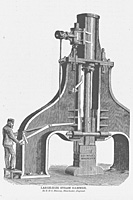Use of Thermal Energy
– from the Steam Engine to the Gasoline Engine
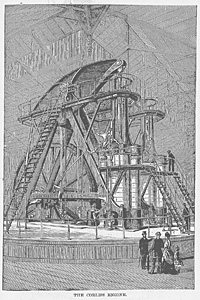 This is an image of a huge steam engine that operated machinery in the Machinery Hall of the Philadelphia International Exposition of 1876. Also exhibited in the same hall was a gas engine. A few years later, a gasoline engine was developed.
This is an image of a huge steam engine that operated machinery in the Machinery Hall of the Philadelphia International Exposition of 1876. Also exhibited in the same hall was a gas engine. A few years later, a gasoline engine was developed.
A prime mover is a device that continuously transforms thermal, electric, hydraulic and other energies into motive power. Prime movers that use thermal energy are called heat engines, which are divided into the following two categories:
*For heat engines using electricity as a power source, see "Use of Electric Energy"
- 1.External combustion engine
- generating motive power indirectly through the heat produced from the combustion of fuel Examples: steam engine, steam turbine, etc.
- 2.Internal combustion engine
- generating motive power directly from the gas produced by the combustion of fuel Examples: gas engine, gasoline engine, Diesel engine, etc.
From Gunpowder to Steam – Birth of the External Combustion Engine
It was during and after the Industrial Revolution that a heat engine began to be fully used as a machine for generating significant power. In the 17th century, efforts were made to pump water with an external combustion engine using gunpowder or steam. Around that time, drainage was a major difficulty in coal mines. In 1712, T. Newcomen developed pumping equipment in which the combustion of coal turned water into steam, then atmospheric pressure pushed down a piston in a cylinder following the condensation of cooled steam into water, and motive power was generated. This equipment was used in many coal mines.
Development of the Steam Engine
Newcomen's steam engine had a low thermal efficiency. Subsequently, J. Watt (succeeded in achieving efficient power generation through the use of a steam condenser. The thermal efficiency of the steam engine that he improved in 1776 increased dramatically. In the 1780s, the improved version rapidly became widely used as a power source for pumping equipment. Watt made further improvements. The power of steam engines replaced that of waterwheels,* and came into wide use in factories. At iron and steel works, steam hammers were often used. In 1803, the world's first steam locomotive was completed, followed by a steamship being put into practical use in 1807. In 1884, C. A. Parsons obtained the patent of a steam turbine (with rotating impellors). This was used as a power source for vessel operation and electricity generation.
Thus, widely applied in various fields, such as mining, iron and steel production, and logistics, steam engines were developed as a driving force in the Industrial Revolution. In the late 19th century, however, attention began to be paid on their shortcomings, such as their inappropriateness for transportation due to their large size, the frequency of boiler explosion accidents, and their low thermal efficiency. Particularly, as a means of transportation, a lighter and more efficient power source was required. Developed in response to such a demand was an internal combustion engine.
*Various efforts continued to be made regarding the use of hydraulic energy; a hydraulic engine was exhibited at an international exposition.
Invention of the Internal Combustion Engine
It is said that today's internal combustion engine, which generates motive power through the combustion of an air-fuel mixture in an enclosed space, was devised by R. Street in 1794. This was followed by the practical use of a gas engine by J. J. E. Lenoir in 1860, giving birth to the world's first internal combustion engine. This was a two-stroke engine using a coal gas/air mixture, with a thermal efficiency approximately three times higher than that of a steam engine. His engine was exhibited at the second Paris International Exposition of 1867. At this international exposition, N. A. Otto Otto and E. Langen were granted the Grand Prize in recognition of their fuel-efficient free-piston engine, in which a piston moved up at the time of gas combustion and then came down under atmospheric pressure. In 1876, Otto developed a prototype of a four-stroke gas engine which involved intake, compression, expansion and exhaust. In 1877, he obtained a patent for this engine. His engine had high output and thermal efficiency, as well as a low noise level.
Changes of Fuels – From Coal to Petroleum
Since coal gas was used as the fuel for these internal combustion engines, a gas generator and other heavy equipment were needed when the engines were used for transportation. In this regard, research was conducted into the use of gasoline, a form of refined petroleum, as a fuel, which had a high heat value per volume and high portability.
In 1883, G. Daimler developed a four-stroke gasoline engine engine with a carburetor for gasoline, successfully creating a smaller, higher-performing engine. For internal combustion engines, an ignition device was important. He obtained a patent for spontaneous ignition with the placement of a hot-tube to send the heat into a cylinder. In 1886, C. F. Bentz manufactured the world's first practical gasoline automobile (a three-wheeled vehicle). Also, a two-stroke gasoline engine was developed, followed by the invention of the first practical type by D. Clerk in 1881, and then the creation of a new type engine by J. Day in 1891. Day's engine was more compact than a four-stroke engine, leading to wide use of his engine for motorbikes and motorboats in the 20th century. In 1887, R. A. Bosch completed a spark ignition system using a magnet dynamo, followed by the development of gasoline engines, such as the invention of a spray-type carburetor by W. Maybach in 1893.
Subsequently, demand grew for the development of an engine using low-quality oil as a replacement for gasoline fuel. In 1893, R. Diesel published an idea regarding a compression-ignition engine (a Diesel engine) which uses the light oil as a fuel, and actually built such an engine in 1895, paving the way for the use of low-priced light and heavy oils.
The period from the 1870s to 1890s was a golden age during which the foundation of today's engine technologies technologies was established. Experiencing two World Wars, the technological development was further accelerated for its application to military aircraft and weapons, further promoting the development of heat engines.
Steam Hammer
One of the machines that used a steam engine was a steam hammer. This image depicts a steam hammer exhibited at the Philadelphia International Exposition of 1876. The hammer moved vertically and made quick and powerful strokes. Without such a steam hammer or machine tools for cutting and other processes, it would have been impossible to make machines with sufficient strength and precision. Also, a steam hammer was used for steel tempering, which was indispensable to the development of vessels, as well as cannons and guns.
External combustion engine (14 images)
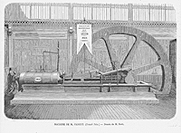 |
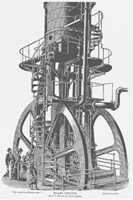 |
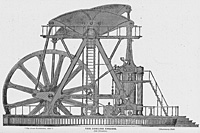 |
| Farcot's Horizontal Steam Engine | I. P. Morris' Steam Engine | Corliss Steam Engine Exhibited by Corliss Steam Engine Co. |
Steam Hammer, etc. (10 images)
 |
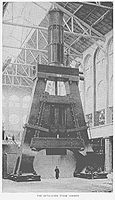 |
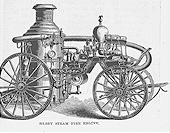 |
| Steam Hammer for Which Patent Was Obtained by Nasmyth | 125-ton Steam Hammer Exhibited by Bethlehem Iron Co. | Silsby's Steam Fire Engine |
Internal combustion engine (3 images)
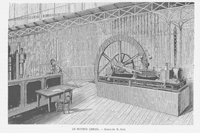 |
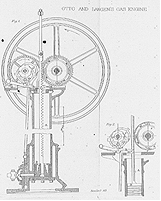 |
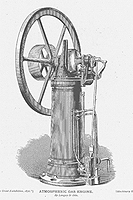 |
| Lenoir's Gas Engine | Langen and Otto's Gas Engine | Improved Version of Langen and Otto's Gas Engine |
- References:
-
Arai, Hisaharu. : Enjin shinka no kiseki: Joki enjin kara kankyo enjin e (Sankaido, 1998) <NB85-G16>
Dickinson, Henry Winram; Isoda, Hiroshi (tr).: Joki doryoku no rekishi (Heibonsha, 1994) <NB83-E13>
Higaki, Kazuo.: Enjin no ABC: Gasorin enjin, jetto enjin kara gainen kikan made (Kodansha, 1996) <NB85-G5>
Singer, Charles Joseph (et al) (ed); Takagi, Junichi (tr. and ed.).: Gijutsu no rekishi 9 Enlarged ed. (Chikuma shobo, 1979) <M31-47>
Suzuki, Takashi.: Enjin no roman: Hasso no tankai to ikusei no kuto (Miki shobo, 2002) <NB85-H1>

